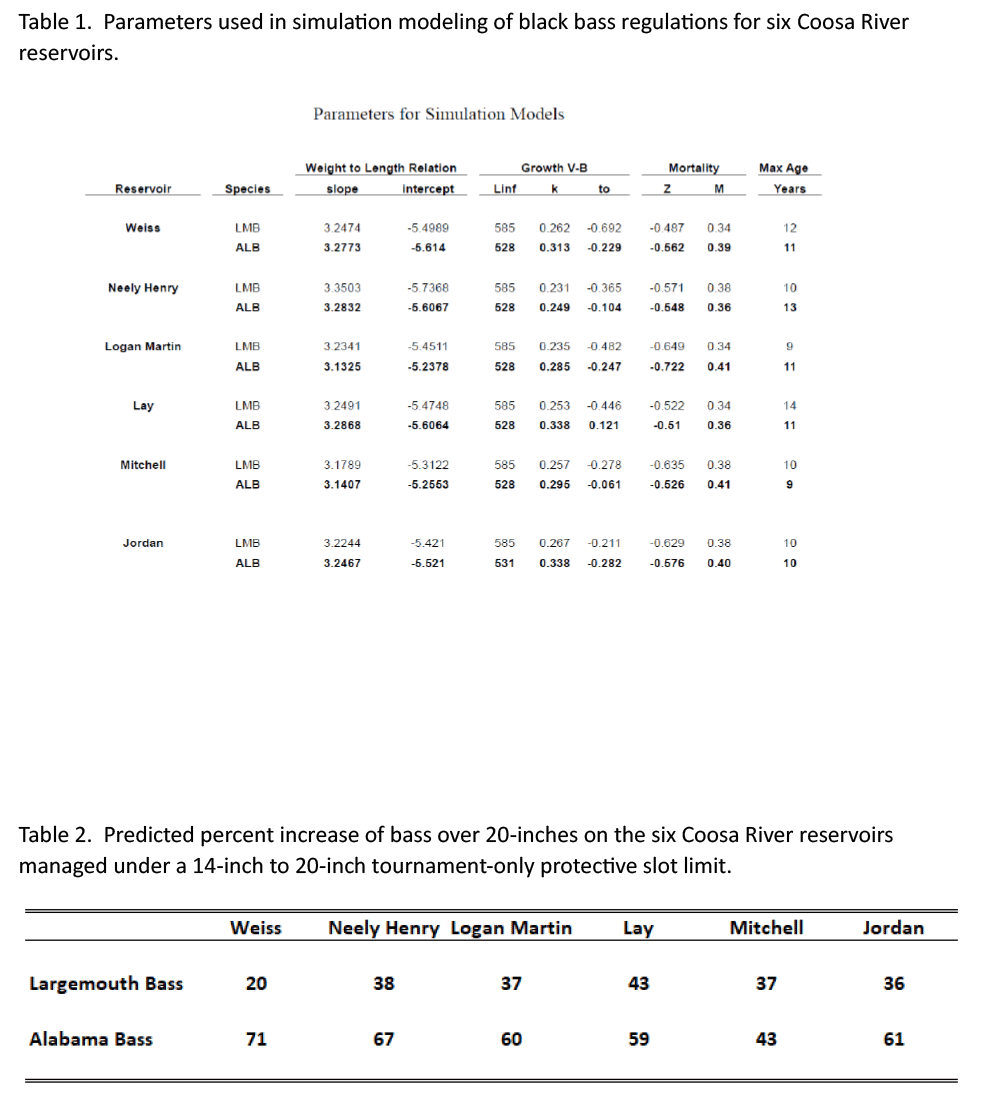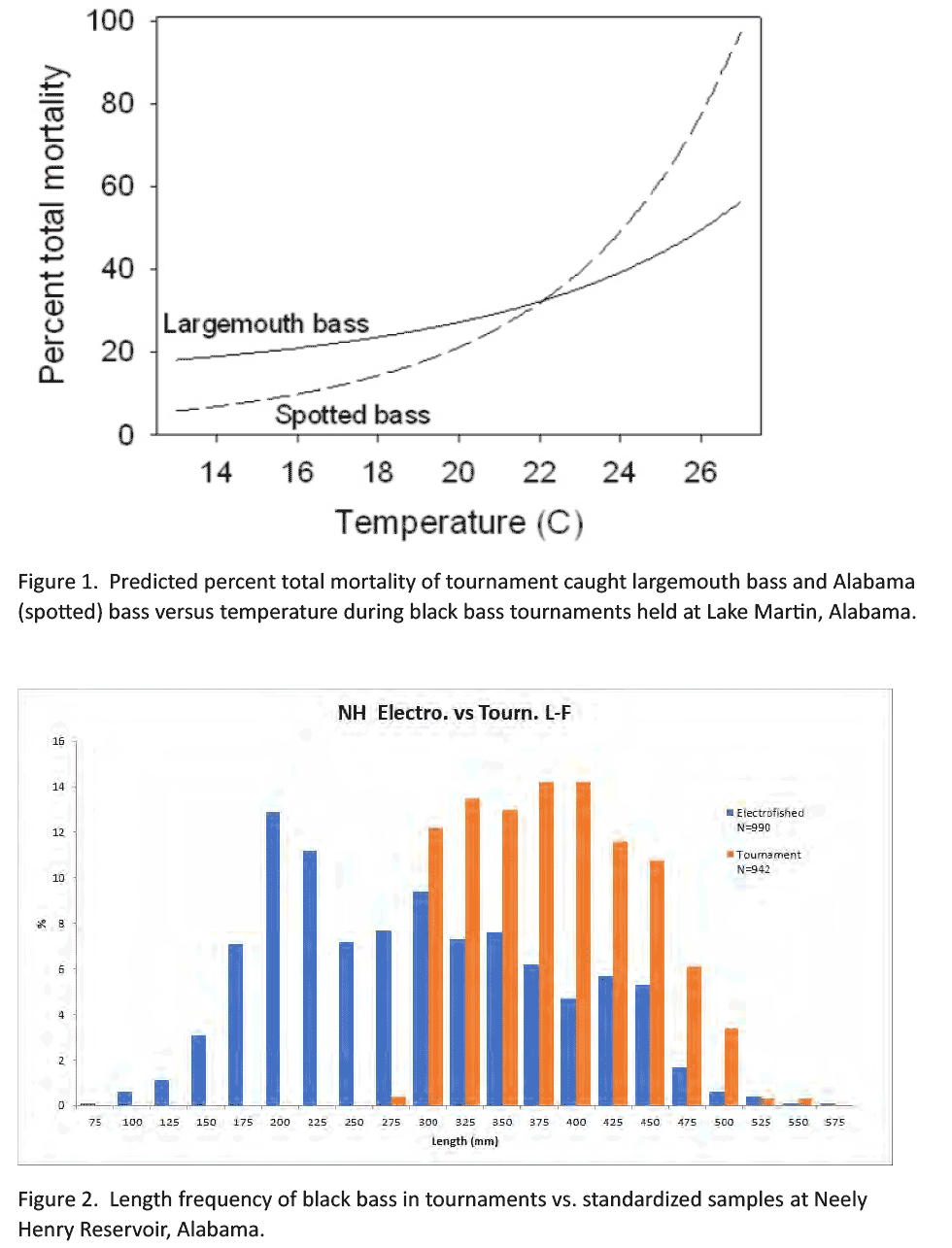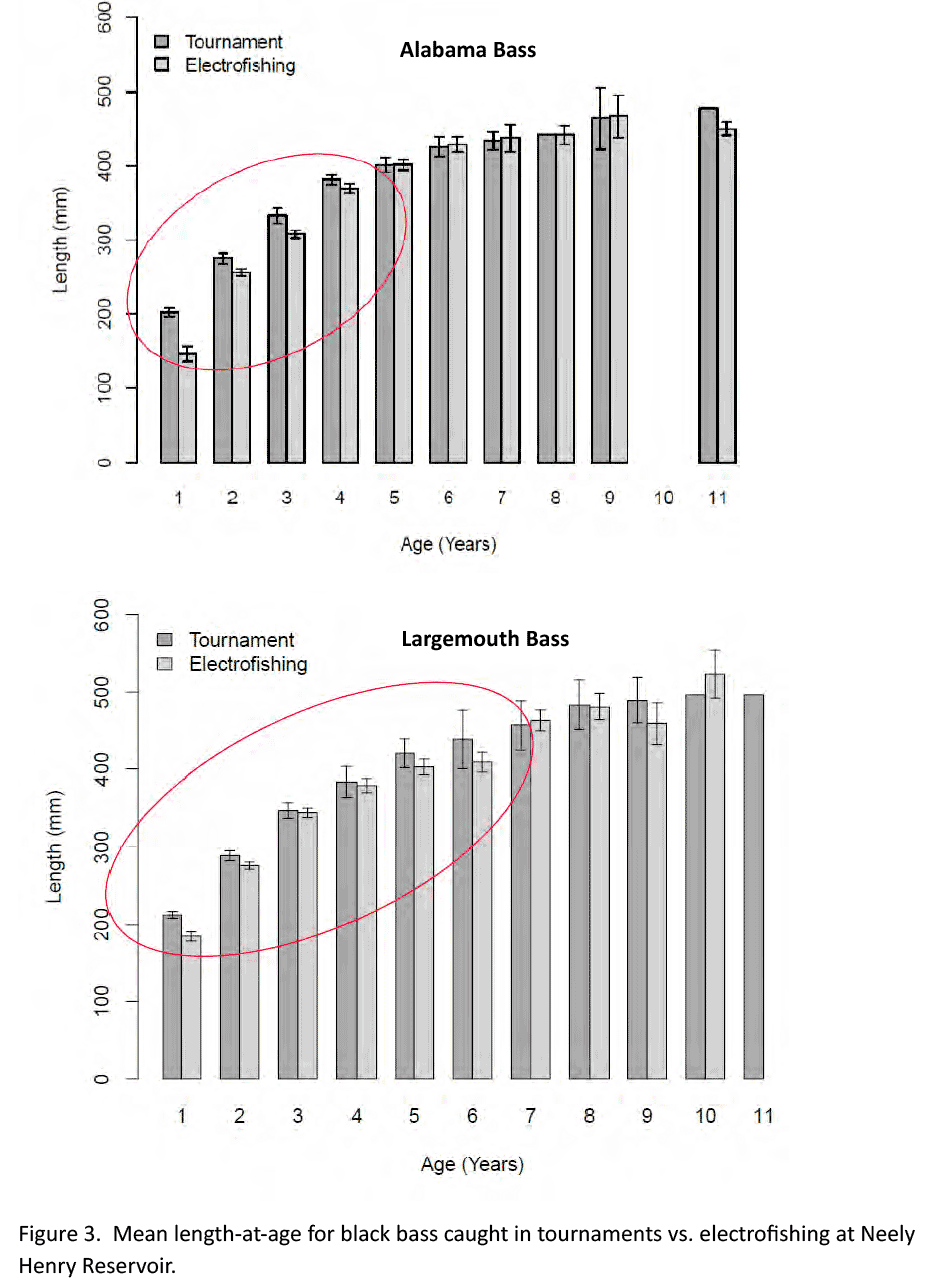Recommendation for Black Bass Regulation Changes on Coosa River Reservoirs
Introduction:
In response to persistent complaints from anglers about the declining quality of the black bass fisheries on Coosa River reservoirs, ADCNR funded a three-year research project through Auburn University to examine the impact of bass tournaments and mortality of Largemouth Bass and Alabama Bass on Neely Henry Reservoir near Gadsden, Alabama. Neely Henry Reservoir was chosen due to several factors that made it suitable for the project. Neely Henry has high tournament activity, good amenities and local lodging, boat ramps that provided access to most of the reservoir for tracking fish, as well as fishery characteristics that made it suitable for the research project. Total project cost was $843,000. The project is complete and we have reviewed the data, although the results have not yet been published.
Methods:
Our population modeling used variables obtained from portions of the Auburn University study, and from our long-term standardized sampling database. All variables are scientific estimates based upon the results of these studies. Table 1 shows the parameters used to perform the simulation modeling.
The Neely Henry study estimated very high annual capture rates for Largemouth Bass (80%) and Alabama Bass (120%). However, only 2% of captured Largemouth Bass and 4% of captured Alabama Bass were harvested by recreational anglers. Forty percent (40%) of the total capture events occurred during tournament competitions. It was estimated that a total of 45% of bass weighed in during tournaments suffered pre- and/or post-release mortality. This is likely a conservative estimate, as research has shown that total tournament mortality can range from 50 – 80% during hot weather (Figure 1). As high school and collegiate tournaments have increased, the number of summertime tournaments has also increased.
Results/Discussion:
On Neely Henry, capture rates were very high for both species. For comparison, a study at Lake Guntersville estimated annual capture rates of Largemouth Bass at about 50%. Both reservoirs receive heavy tournament pressure that negatively impacts the size-structure of their bass populations. However, Neely Henry is 6-times smaller, more riverine, and does not have expansive overbank areas that offer good black bass habitat. Because the Coosa River reservoirs are small, and more vulnerable to the effects of tournament mortality, they can only withstand a fraction of the tournament pressure that larger reservoirs receive. To put things into perspective, Neely Henry, Logan Martin, Lay, Mitchell, and Jordan Reservoirs combined total less than 75% of the total surface acreage of Lake Guntersville.
Tournament anglers target the largest fish they can catch in an effort to have the heaviest weight and win the largest prizes. Figure 2 shows how the size of bass weighed in during Neely Henry bass tournaments compared to the population at-large. The large fish targeted by tournament anglers represent a relatively small proportion of the total population, so high mortality on this segment of the population can quickly reduce the abundance of larger fish. As an example, the relative abundance of 19-inch & 20-inch bass caught by Neely Henry tournament anglers was almost four times greater than their relative abundance in the population.
Females of both species were disproportionally selected by tournament anglers because they are heavier than males at all sizes, and because the maximum size of males is generally limited to about 18-inches (≈3 pounds). Therefore, to accumulate the heaviest weight possible, competitors weighed in 50% more females than males. This disparity was greatest among bass older than Age-6, where nearly 70% of all bass weighed in during tournaments were females. This resulted in female bass suffering higher rates of tournament mortality.
Tournament anglers were also unknowingly selecting for faster growing fish, which subjected them to higher rates of mortality than slow growing fish. Figure 3 helps to illustrate this by comparing mean length-at-age of electrofished vs. tournament caught bass. This difference is evident at the younger ages but disappears at the older ages because most of the faster growing fish have been eliminated from the population by Age-6 (Largemouth Bass) and Age-4 (Alabama Bass). Genes for faster growth are still present in the population and being passed on to their progeny, but fish that possess them are suffering high rates of tournament mortality before realizing their full growth potential.
Finally, it is estimated that approximately 70% of the total tournament-related mortality is being caused by competitors who do not have enough weight to earn any prizes.
In summary, Neely Henry tournament anglers are selecting for large, fast growing, females, which subjected these three groups to the highest rates of tournament mortality. High capture rates are a function of small reservoir size, which compounds the effects of tournament mortality. Harvest rates are very low, meaning tournaments are causing the majority of angling-related mortality. Therefore, reducing tournament mortality is the best way to improve bass size structure.
Management Implications:
Bass fishing has evolved over the past 30 years. Traditional length and bag limits were designed to manage harvest. These management strategies are ineffective on reservoirs with harvest rates near zero. The effectiveness of traditional length and bag limits has essentially been neutralized by the catch-and-release ethic. However, contrary to what many tournament anglers believe, released tournament fish have high mortality rates, particularly during warmer weather. Numerous studies, including our Neely Henry study, have documented that catch-and-release is most effective when done at the time of catch. The benefits of catch-and-release are negated by hours spent in livewells and the subsequent live weigh-in process that is associated with typical bass tournaments.
In theory, a very high minimum length limit would help to address overall mortality, but it would severely penalize recreational anglers who are far more numerous and are responsible for a much smaller proportion of the total mortality than tournament anglers. Therefore, a restrictive tournament-only slot limit would yield better results in significantly improving size structure, particularly for Alabama Bass.
For size-structure to improve, tournament mortality must be reduced. There are a number of ways this could be accomplished: 1) limiting tournament size and/or frequency, 2) prohibiting tournaments during times when water temperatures are above 70°F (approximately May 1 – September 30), 3) mandating catch-weigh-release tournament formats, or 4) restrictive length limits. The first two options are less desirable because of their potential economic impacts to local communities. The second two options would reduce mortality within the current tournament framework, without regulating participation.
States like North Carolina and West Virginia have enacted regulations that limit the size of tournaments based upon the capacity of the access areas where tournaments are being held. Other states have developed tournament permitting protocols (Florida, Arkansas, Oklahoma, New York, South Carolina, etc.).
Trophy-sized Alabama Bass is something the Coosa River is known for, nationwide. Because of unregulated tournament mortality, our trophy Alabama Bass fisheries no longer exists. Anglers have transplanted Alabama Bass into drainages outside their native range trying to recreate what we once had in our Coosa River reservoirs. Unfortunately, their efforts have failed, and Alabama Bass have naturally hybridized with Smallmouth Bass, Shoal Bass, and Redeye Bass, which is destroying many well-known fisheries throughout the southeast. This is giving the Alabama Bass a bad reputation. Restoring our trophy Alabama Bass fisheries will make the Coosa River a destination fishery again.
Since recreational harvest is responsible for a negligible amount of the total annual mortality, regulations that change recreational angler behavior would not result in noticeable improvements in the quality of these fisheries.
It is our hope that a tournament-only regulation will encourage more tournament organizations to voluntarily adopt the catch-weigh-release formats being used by Major League Fishing (MLF) for its Pro Tour events. This model is also being used almost exclusively by the kayak tournament trails and other conservation-minded bass clubs. Catch-weigh-release would essentially eliminate tournament mortality for all ages and sizes of black bass, and result in the greatest possible improvement in the quality of these fisheries.
Most tournament trails encourage the weighing of non-competitive bags of fish in order to award points to anglers/teams to qualify them for a more exclusive, larger payout, tournament
at the end of the season. Obviously, this practice is inflating mortality by encouraging all anglers/teams to weigh fish even when they do not have enough weight to earn a prize. Eliminating this practice would not prevent lengthy livewell confinement, but it would decrease mortality directly associated with the weigh-in process.
Applying the same regulation change to all six (6) Coosa reservoirs would ensure that angling will be improved for all bass anglers who fish Coosa River reservoirs, and that no local municipalities will be disproportionately affected by a loss of tournament participation. Applying a regulation to only one Coosa River reservoir could result in tournament organizations favoring adjacent reservoirs to avoid the restrictive limits.
Recommendations:
We recommend a 14-inch to 20-inch protective slot limit for all black bass during any tournaments utilizing live weigh-ins on all six (6) Coosa River Reservoirs (Weiss, Neely Henry, Logan Martin, Lay, Mitchell, and Jordan). Table 2 shows the predicted increase in abundance of bass greater than 20-inches in each reservoir under the proposed regulation, which ranges from 20 – 43% for Largemouth Bass, and from 43 – 71% for Alabama Bass.
This regulation has been discussed with and is supported by the WFF Law Enforcement Section. There would be no need for its conservation officers to distinguish between tournament and recreational anglers on the water because it could easily be enforced at the time of the weigh-in.
Initially, tournament weights will be significantly impacted as there are currently very few fish exceeding the upper end of the protective slot. However, each year, survival and growth of fish protected by the slot limit will result in increases in abundance of fish over 20-inches in length.
Perhaps the greatest benefit of this regulation would be to increase voluntary participation in catch-weigh-release tournament formats. This would allow tournament organizations to credit its competitors with catches of all fish within the protective slot limit. Their immediate release following the catch and weighing would reduce tournament mortality to near zero.





